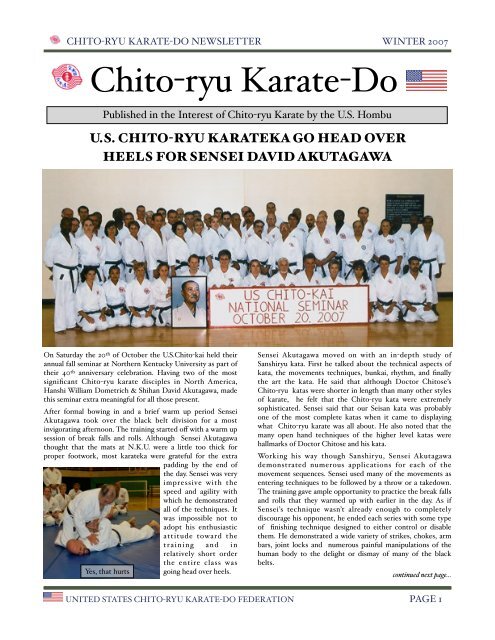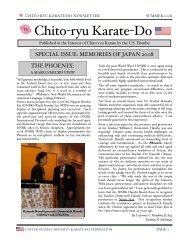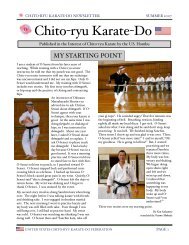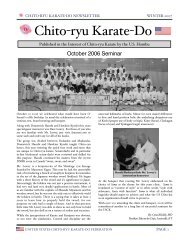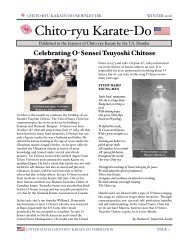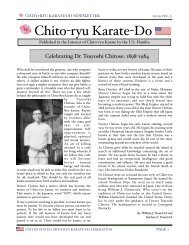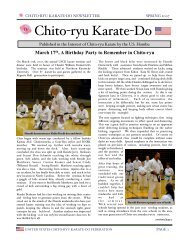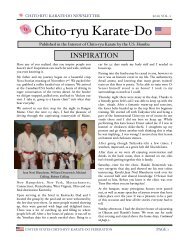winter 2007 - United States Chito-ryu Karate Federation
winter 2007 - United States Chito-ryu Karate Federation
winter 2007 - United States Chito-ryu Karate Federation
You also want an ePaper? Increase the reach of your titles
YUMPU automatically turns print PDFs into web optimized ePapers that Google loves.
CHITO-RYU KARATE-DO NEWSLETTER WINTER <strong>2007</strong><strong>Chito</strong>-<strong>ryu</strong> <strong>Karate</strong>-DoPublished in the Interest of <strong>Chito</strong>-<strong>ryu</strong> <strong>Karate</strong> by the U.S. HombuU.S. CHITO-RYU KARATEKA GO HEAD OVERHEELS FOR SENSEI DAVID AKUTAGAWAOn Saturday the 20 th of October the U.S.<strong>Chito</strong>-kai held theirannual fall seminar at Northern Kentucky University as part oftheir 40 th anniversary celebration. Having two of the mostsignificant <strong>Chito</strong>-<strong>ryu</strong> karate disciples in North America,Hanshi William Dometrich & Shihan David Akutagawa, madethis seminar extra meaningful for all those present.After formal bowing in and a brief warm up period SenseiAkutagawa took over the black belt division for a mostinvigorating afternoon. The training started off with a warm upsession of break falls and rolls. Although Sensei Akutagawathought that the mats at N.K.U. were a little too thick forproper footwork, most karateka were grateful for the extrapadding by the end ofthe day. Sensei was veryimpressive with thespeed and agility withwhich he demonstratedall of the techniques. Itwas impossible not toadopt his enthusiasticattitude toward thetraining and inrelatively short orderthe entire class wasYes, that hurts going head over heels.Sensei Akutagawa moved on with an in-depth study ofSanshi<strong>ryu</strong> kata. First he talked about the technical aspects ofkata, the movements techniques, bunkai, rhythm, and finallythe art the kata. He said that although Doctor <strong>Chito</strong>se’s<strong>Chito</strong>-<strong>ryu</strong> katas were shorter in length than many other stylesof karate, he felt that the <strong>Chito</strong>-<strong>ryu</strong> kata were extremelysophisticated. Sensei said that our Seisan kata was probablyone of the most complete katas when it came to displayingwhat <strong>Chito</strong>-<strong>ryu</strong> karate was all about. He also noted that themany open hand techniques of the higher level katas werehallmarks of Doctor <strong>Chito</strong>se and his kata.Working his way though Sanshi<strong>ryu</strong>, Sensei Akutagawademonstrated numerous applications for each of themovement sequences. Sensei used many of the movements asentering techniques to be followed by a throw or a takedown.The training gave ample opportunity to practice the break fallsand rolls that they warmed up with earlier in the day. As ifSensei’s technique wasn’t already enough to completelydiscourage his opponent, he ended each series with some typeof finishing technique designed to either control or disablethem. He demonstrated a wide variety of strikes, chokes, armbars, joint locks and numerous painful manipulations of thehuman body to the delight or dismay of many of the blackbelts.continued next page...UNITED STATES CHITO-RYU KARATE-DO FEDERATION PAGE 1
CHITO-RYU KARATE-DO NEWSLETTER WINTER <strong>2007</strong>2008 has arrived, a new year, perhaps a new start, or re-start.There were once two men who went to work for the same company on the same day, inthe same year. Twenty years, later one of the men was the head of his section within thecompany while the other was the president of the company. Both men were brothers,twin brothers, and they both had equivalent educations. What happened? The samething that happens every day in every aspect of our lives to similar people.The one brother (lets call him section leader Roger) had accumulated twenty years ofexperience while the other brother (lets call him president Nick) had also accumulatedtwenty years of experience. The difference was beginners mind; an oft discussed subjectin the martial arts. Roger had twenty years of experience - the same year over and over.Nick had twenty years of growing in the job. He became wiser and more proficient as hedeveloped into the man his boss was looking for.This year lets attempt to grow and learn, more so than in the past. Lets look at life as anadventure, and every day try to learn something new. Look at the world as a big present;a gift. Look, listen, experience and learn. Don’t take yourself too seriously, but take lifeseriously. It is all you really have; so use your karate-do to enrich your life. Be kind, treateveryone as brothers and always cultivate your beginners mind.continued #om #ont page...By: Wi!iam J. Dometrich, HanshiUS <strong>Chito</strong>-kai FounderAfter taking a post seminarpoll, perhaps “Akutagawa“should be pronounced “Ouch-I-got-ya”.In addition to the Saturdayseminar, Sensei Akutagawawas most generous with histime over the rest of theweekend. On Friday eveninghe sat with the NationalTest Board for the BlackBelt test, which lastedHead over heels, literallyseveral hours. Despiterunning late into the evening , he took the time to address each test candidate and gaveeveryone positive criticism and encouragement. Saturday evening was spent at thebanquet, and Sunday Sensei held and extra training session for the upperranked instructors.One would be at a loss to describe Sensei Akutagawa with just a few words, but somethe following come to mind: inspirational, motivational, budo spirit, excellent technique,and the open minded attitude of the great jazz improve saxophonist Art Pepper (youhad to be there). Finally, it goes without saying that this was one great <strong>Chito</strong>-<strong>ryu</strong> karateweekend. Thank you a thousand times to Sensei Akutagawa for sharing your time, yourknowledge, and especially special personality.Bonsai ! Bonsai! Bonsai!EDITORIAL:A MESSAGEBy: John F. We!brockHombu DojoTHE KARATE-DOSTAFFBarbara DometrichOkusan@chito-<strong>ryu</strong>.comEditor-in-ChiefHombu DojoCyna Khalily, MDCovington, KYCyna.Khalily@chito-<strong>ryu</strong>.comAssistant EditorYoseikan Taka no koLouisville, KYCONTRIBUTORSWilliam J. DometrichJohn F. WellbrockSherry KembreDon SchmidtJamie BinkleyJames AcamporaMichael MessingerRenea DunnWillie ElliottMina K. LudwigThe <strong>United</strong> <strong>States</strong><strong>Chito</strong>-<strong>ryu</strong> <strong>Karate</strong>-do<strong>Federation</strong>22 Martin StreetCovington, KY 41011859-291-7232www.chito-<strong>ryu</strong>.comUNITED STATES CHITO-RYU KARATE-DO FEDERATION PAGE 2
CHITO-RYU KARATE-DO NEWSLETTER WINTER <strong>2007</strong>FOUNDER’S FORUMTitles, titles, and more titlesEgocentrism is rampant among exponents of modernbudo. All exponents at some time become embroiled inheated rivalries propagated by ambitious leaders vyingfor dominance of organizations that have been createdto further the progress of the various <strong>ryu</strong>. Examples ofthe failure of exponents to achieve spiritual maturityabound. Many exponents of today’s modern budo gropearound in a maze of classical traditions that they do nottruly understand. Many exponents of the martial artsexpect to reach a high degree of technical skill andleadership but ha ve failed in the most basicunderstanding of the essence of the art of budo. Manysenior students have been given key positions within anorganization only to fail as authority is thrust uponthem. They fail because their own self importancebecame more important to them than their sensei, orthe mission of the style and organization.The purpose of modern budo is to strengthen yourselfphysically, mentally and spiritually. To be better able toserve your sensei, your family, your neighborhood, yournation and the world in general. Ego is the biggesthandicap to proper understanding of the essence of themartial arts. The essence of martial arts training is notto finish; it is the trip. What then, does this have to dowith titles?When I first started in the study of karate-do over 50years ago I called my teacher “sensei”. Now we haveSensei, Shihan, Renshi, Kyoshi, Hanshi, Hanshi-sei andothers. Some more modern based styles have masters,grand masters and great grand masters. I was at the dojoone day as some of the older students were introducedto a visiting martial arts practitioner a few minutesbefore class started. It sounded something like this:“This is Renshi Murphy, I would also like tointroduce you to Sensei Jones and KyoshiJohnson. Those two working out together areShihan Rodgers and Sensei Green”.As this continued I began to feel as if I was in a MarxBrothers movie. The title Sensei has many applicationsin Japan. Doctors are Sensei of good health; lawyers areSensei of rules of society. Police are Sensei of socialorder. Because karate-do is a martial art, lets take a lookat the military for some guidelines. I address an Lt.Colonel in the Army as “Colonel” not LieutenantColonel. I address a General as “General” not BrigadierGeneral, Major General or Lieutenant General.In the martial arts, we should introduce everyone as“Sensei”. Sensei is a good word and sufficient for allpeople on all occasions. Introductions might sound likethis: “I would like to introduce you to the U.S. <strong>Chito</strong>-kaiChairman, Hawkins Sensei, or our U.S. <strong>Chito</strong>-<strong>ryu</strong>founder Dometrich Sensei. Lets stop wearing the titlesout - it is starting to sound like a big ego trip. One of thegoals of budo is to kill the ego.Lets stop feeding it, call everyone Sensei and you can’tgo wrong.Editors Note: About Japanese titlesBy: Wi!iam J. Dometrich, HanshiUS <strong>Chito</strong>-kai FounderThe titles we use in the US <strong>Chito</strong>-kai are those originatedby the Dai Nippon Butokukai in the early 1900s. According toPatrick McCarthy, the original titles were Hanshi and Tasshi.Tasshi was later replaced with Kyoshi (although Tasshi stillseems to be used occasionally) and the title Renshi was addedlater. The literal translations are inconsequential, but they allinclude the character “shi” which roughly equates to teacher orexpert, and then there are various iterations of “highlyqualified” or “well trained”. These are all “Shihan” or “masterteacher” titles. We like to say Shihan is to Sensei as Professoris to teacher. In Japan, Sensei and Shihan are used inconversation and salutations, the other titles are not. You willnever hear someone say “Hello Renshi Yoshida”. Much lesswill you ever hear someone refer to themselves by their title,or even as Sensei for that matter. “My name is SenseiBlowhard” is a totally unacceptable conveyance. It isacceptable to include someone’s title when introducing themand it is appropriate to include ones own title on officialwritten correspondence. But to sign ones own correspondenceas “Sensei Smith” is not appropriate.Also, in Japanese, salutations are usually placed after thename, as in: Nakamura Shihan. But they also tend to put thelast name first so I think that our western custom of using thesalutation first as in “Sensei Monkeyfoot” if not literallyprecise, is probably OK based on usual and customaryAmerican parlance. You will hear it used both ways in English.In the USCK our Renshi, Kyoshi and Hanshi titles are allcertified by the DNBK. Other organizations may use thetitles but they are not necessarily recognized by the DNBKThat being said, we will likely continue to call DometrichSensei “Hanshi”, mostly because we like it that way.CKUNITED STATES CHITO-RYU KARATE-DO FEDERATION PAGE 3
CHITO-RYU KARATE-DO NEWSLETTER WINTER <strong>2007</strong>INSTRUCTOR PROFILE:Name: James AcamporaJAMES ACAMPORABorn: February 3 rd , 1956Abbington PAChildren: Desiree 21yrsand Destiny 18yrsEducation: Bachelors inComputer Science,Plumber, and school ofhard knocksCurrent Employment:Owner/ Manager of HomeRemedy Remodeling Co.Specializing in bathroomremodelingMa r t i a lA r t sE x p e r i e n c e : Startedtraining in <strong>Karate</strong>-dounder Shihan Art Rott in1981, Longwood Florida. Started teaching for Shihan Rott inthe 90’s at the Yoseikan of Orlando dojo. Started Yoseikan ofOrlando II in Altamonte Springs Florida.<strong>Karate</strong> Rank and Title: Yon-Dan <strong>Chito</strong>-Ryu and ChiefInstructor of Yoseikan II of Orlando dojoExtra Curricular activities: Ball room dancing and fitnesstraining.Things that are important to you: My Children arenumber one with <strong>Karate</strong> training running second.Professional affiliations: Security officer for NorthlandCommunity Church with a congregation of 17,000.What’s on my night-stand: Besides bills, Japaneseinstruction in preparation for upcoming trip to Japan.I am proud and honored to have a Chartered <strong>United</strong> <strong>States</strong><strong>Chito</strong>-Ryu Dojo under Hanshi Dometrich in the fine traditionstarted here in Florida by Shihan Art Rott.James has honored his sensei, by picking up the reins after hisdeath and establishing a dojo at his home to carry on for hissensei Shihan Rott. James has also picked up the tradition thatShihan Jim Matthews started in south Florida of a <strong>winter</strong>getaway for all the northern karate-ka to get out of the badweather up north in February. James is an excellent organizerand a big asset to the <strong>United</strong> <strong>States</strong> <strong>Chito</strong>-kai.Something to SayI want to start by saying what I feel;WOOD AND FOOD ARE SEASONED.WHISKEY AND WINE ARE AGED.A WELL BUILT MUSICAL INSTRUMENT DEVELOPS ABETTER QUALITY THE MORE YOU PLAY IT.CEMENT WILL TAKE UP TO FOURTY YEARS TO CURE.What I am trying to say is that I have been watching a groupof 50 year veterans of <strong>Chito</strong>-<strong>ryu</strong> karate that are 50 years + andseeing in my book what is called as good as it can be.This group is seasoned, aged, sound, toned, and hardened in away they should be.THEY ARE HARD BUT SOFT SPOKEN.T H E Y A R E S E AS O N E D W I T H Y E A RS O F H A R DTRAINING AND GUIDANCE.THEY ARE SOUND AND TONED SO WHEN YOU SEETHEM PERFORM OR INSTRUCT, PEOPLE WATCH ANDLISTEN TO THEM.Watching them instruct our new generation, which is nowharder to train because of our society and parenting of today,they are still able to do a good job. It makes me very proud ofwho I am and that I can say that I belong in this group.Hanshi can pick any one of these fine people to do a fine joband they can handle anything at a moments notice and he cango to do something else knowing everything is going to turnout great.At one point in time I think there was some little doubt aboutus 50 years olds, because we might have been brought up withhard old school training (if you have been there you know whatI mean) but seeing is believing, I know that we believed inHanshi Dometrich and Okusan and that is what made us whatwe have became today.A CHIP OFF THE OLD BLOCKAN APPLE NOT FAR FROM THE TREEMOST OF ALL PEOPLE WITH SOULThank you Hanshi and Okusan for being the mold for usantiques.P.S. There will be many more 50 year olds to carry on.By: Michael A. MessingerYoseikan Bridgeport, WVUNITED STATES CHITO-RYU KARATE-DO FEDERATION PAGE 4
CHITO-RYU KARATE-DO NEWSLETTER WINTER <strong>2007</strong>Good TimesOn the morning of October 20, <strong>2007</strong>, two days after O-Sensei’s109 th birthday, members of the USCK Board of Directors, dojoheads and shihan-kai met to discuss the progress and thepotential of the USCK. The overall tone was one of success andhope.Hanshi was pleased to report that, since 2004, our organizationhas grown by 30%. Chairman Hawkins urged us all to thinkbeyond what we think is possible in terms of future growth anddevelopment. As proof and motivation, he sagely pointed outthat in the “Bruce Lee Hey Day” of the 70’s, Hanshi did not havea cadre of black belts at his disposal. Yet and still, the USCKhad 1000 members. With the depth and breadth of experienceand the sheer number of skilled black belts in the organizationtoday, we can and should be able to exceed 1000 members whilestill maintaining and even improving the outstanding standardsof training and traditional martial spirit.Vice Chair, Sherry Kembre discussed mission and visionstatements of the USCK which coincide the goal of growth andcultivation of O-Sensei’s legacy. Members of the organizationare encouraged to maintain communication and share ideas ofsuccess.Dr. Laura Stith (AKA Deck) joined the meeting to discuss thechallenge and hope for the future which lies with our children.Recently featured on local news channels as an expert in childand adolescent psychology, Dr. Stith was able to explain thevarious stages of developmental growth. This shed considerablelight on what children are capable of mentally and physically ineach of the age specific stages. She reinforced the importance ofeducating ourselves about our students in order to determine thebest and most effective methods of teaching. Listening to Dr.Stith brought home the fact that we now have so many skill setsat our disposal and such a growing wealth of knowledge, theceiling is unlimited in terms of our potential.Hanshi spoke briefly about the modalities of future teachingresources. Watch for DVD’s and <strong>Chito</strong>-<strong>ryu</strong> instructionalmanuals. All of these tools will facilitate teaching and learningand a more uniform promulgation of <strong>Chito</strong>-<strong>ryu</strong>. Hanshi alsoannounced that Gerald Beshears will serve as National ChiefInstructor and Cyna Khalily as Deputy Chief Instructor. Theyserve at the leisure of the Technical Director – Hanshi.Co-founder and Chief Administrator, Kyoshi Dometrich,encouraged the group to be diligent in communication. Thethree primar y modalities for communicating beyondparticipating in the national events and black belt class, aremonthly reports, emails and newspaper contributions. Let’s allstrive to make our Chief Administrator’s job easier.The meeting adjourned on a high note which was sustainedthrough four hours of training and culminated in the annualUSCK banquet. The theme of the Banquet was the 40thanniversary of the USCK. In his visit in to the <strong>States</strong> in 1967, O-Sensei charged Hanshi and Okusan with the duty of establishingthe USCK. He renamed the soon to be Hombu dojo, ‘Yoseikan’,to mirror the name of his own dojo in Japan. No doubt, O-Sensei would be pleased with what the co-founders have doneand with their steadfast loyalty to his legacy.A great and plentiful meal was enjoyed by all, after which wewere treated to a keynote speaker as well as a photo presentationof the USCK history. Sensei Akutagawa was in his speech just ashe was in this teaching and everyday demeanor. His kindnessand generous spirit were bountiful. His love and respect for O-Sensei and for Hanshi were manifest throughout his talk. WhatI found most touching was Akutagawa Sensei’s anecdotes andrecollections of how much O-Sensei loved Hanshi Dometrich.It was bitter sweet to hear about the depth of affection that Dr.<strong>Chito</strong>se felt for his American student. Akutagawa Senseireported that, during his annual visits to Japan, O Sensei spokeoften and with great pride regarding Hanshi and the USCK.I was profoundly grateful that Akutagawa Sensei shared thoserecollections with us. His words and reverent tone buoyed myalready sky high spirit. If you were looking for some affirmation,that was it. Dr. <strong>Chito</strong>se did not just pick some Yankee to teach<strong>Chito</strong>-<strong>ryu</strong> in the <strong>States</strong>, then cross his fingers and hope for thebest. He saw in his student what the student could not see inhimself. He entrusted Hanshi with his legacy and was later,Akutagawa sensei tells us, full of pride and downright boastful ofHanshi’s accomplishments. To be associated with and taught bythe direct, beloved, respected and hand picked link to progenitorof <strong>Chito</strong>-<strong>ryu</strong> is heady brew.We got to see some photo proof of that teacher/studentrelationship in Kembre Sensei’s photo presentation. There wereso many great shots of O-Sensei at the dining room tablecompleting calligraphy on certificates, sitting seiza before hisAmerican progeny, discussing karate with Hanshi in matchingkimonos on the couch, training with Hanshi in the yard and inUNITED STATES CHITO-RYU KARATE-DO FEDERATION PAGE 5
CHITO-RYU KARATE-DO NEWSLETTER WINTER <strong>2007</strong>the dojo, smiling with the family and with students. Togetherwith Kembre Sensei’s recollections, this made for a great end capto the journey down memory lane.The evening ended with awards of rank as well as national andlocal awards from Hanshi and Okusan: Sho Dan – Emma Gage,Lauren Fuller, Reggie Corbett, Michael Shaefer, Karen Ruperto,Suzanne Schlegel; San Dan – Mark Lingo, Regina Rossini; YonDan – James Acampora; Go Dan – Warren Pochinski.National Awards:Yu (Valor) awards in gratitude for military service to our countryin the spirit of <strong>Chito</strong>-<strong>ryu</strong> to Steve Nassano, David Hewitt andWilliam JansakExcellence – Steve Wilhelm and Eric FordOutstanding Dedication, Spirit, Honor – Mina K. LudwigHumanitarian – Wesley ErnestSpecial effort – Kevin Drummond and James AcamporaSpecial service – Cyna Khalily, Willie Elliott and John WellbrockHombu Local Awards:Uchi Deshi – Don SchmidtSpecial Dojo Service – Joseph Petty and Michael SchaeferPer Okusan’s request, somewhere in medias res (‘In the middle ofthings’ – a little Latin for my Sensei’s pleasure) and in order toscore a seat at the grown-up table, I had the honor of reviewingthe highlights of <strong>2007</strong>. In case you missed it, um, apparently Ithought every one of the events in <strong>2007</strong> was ‘a really good time.’Truth, however, is an absolute defense to redundancy. I really didhave a really great time at every one of the <strong>2007</strong> USCK events.But 2008 will hold even better times. See you there and we’llprove it together.By: Mina K. LudwigYoseikan II CincinnatiEach and every student should be preparing for the test withevery class they take. Therefore they should train everyday andevery class as if this is the test day, because in many ways everyday is test day. It is one aspect of life, that test i.e. challenges arewhat makes life and growth possible. An example of this is inthe movie “A League of their own.” In this movie, the characterplays by Gena Davis, tells Tom Hanks, playing her manager, thatshe is going to quit because it just got to be too hard. And TomHanks says: that right, its suppose to be hard, it is the hard thatmakes it worthwhile, if it were easy, everybody would do it. Ithink this summaries tests and life. It is the hard that makes itworthwhile.I would also like to say to students, as you train for your testcontent, specifically the kata for that specific test and/oranything else you need to know. Please do not neglect or forgetyour basics. Many students in this test did not perform Uchi-Hachi Dachi, correctly. In fact, they did not bend their kneesnor turn their toes inward. I, of all people, am very aware of thisbecause on my last test, Hanshi drilled us on Uchi-Hachi Dachifor fifteen minutes, and this was my Yon-Dan test. So, it isimportant for all of us, as always learning and practicing studentsTestingRecently I had the pleasure and honor of sitting on a TestBoard with Hanshi Dometrich and Sensei John Wellbrockassisted us. We tested about 10-15 students in the belt rangefrom white belt to brown belt. All in all, all things considered, itwas a well conducted test which gave each student an indicationof how they were progressing on their journey to being the bestperson they can be. I hope that each student realized that thegoal of karate training is not to obtain belt rank, but to becomethe best person that we can be.I just wanted to make some points about this test and hopefullysome benefits of the testing process itself. First, and mostimportant, a test begins the moment that the student finishedtheir last test. So, for every student, that tested on Saturday andthose that are planning on participating in the next test, whichshould occur in about three months, your test has already begun.that we not neglect nor forget any of the basics. Because it isbasics that make karate the great marital art that it is.Also, students should practice for a test on their own. Each andevery day, students should go over the required materials fortheir test. This is very important for learning, because repetitionis the royal road to learning. It is necessary for students topractice everyday because one day they may be faced with thereal test, the only test, that really matters: and that is theconfrontation on the street with someone who intends to dothem harm. And when students have adequately prepared forthe test in the Dojo, they will be ready for the confrontation onthe street.By: Wi!ie E!iottNKU <strong>Karate</strong> ClubUNITED STATES CHITO-RYU KARATE-DO FEDERATION PAGE 6
CHITO-RYU KARATE-DO NEWSLETTER WINTER <strong>2007</strong>Embu Tai Kai held for Shihan Arthur RottOn November 10 th , <strong>2007</strong>, the annual event was held tocommemorate the passing of Shihan Arthur Rott, a member ofthe USCK Shihan-kai and Chief Instructor of Yoseikan ofOrlando from the early 1970’s through 2001. Arthur Rottowned a grocery store in Covington and became associated with<strong>Chito</strong>-<strong>ryu</strong> karate through his son Bill, who joined the Kushin Kaiin mid 1960’s (later to be renamed the Yoseikan at the request ofDr. <strong>Chito</strong>se). Bill Rott trained hard and in 1967 was promoted toshodan at the age of 15 by Dr. <strong>Chito</strong>se himself. Arthur Rottenjoyed visiting this tough dojo environment, which at the timewas located off Madison Avenue in an alley in a converted 2-storygarage close to his grocery. After watching his son progress forsome time, he joined at the age of 44. Later, he would sell hiswarehouse to William and Barbara Dometrich. It is on thislocation that the existing US <strong>Chito</strong>-kai Honbu now stands.In the 1970’s, he moved to Orlando and began teaching karate athis home. In the late 1980’s he moved to a 5-acre property andbuilt a very large dojo amidst a pine forest, very much resemblinga traditional Okinawan dojo. As he got older he contracteddiabetes, however, health challenges could not kept him out ofthe dojo, and he continued to teach and train until the day hedied. His favorite kata to work on, especially as he got older, wasSanchin.Shihan Art Rott passed away on November 10 th , 2001 at the ageof 83. Just one month earlier, he had attended the <strong>United</strong> <strong>States</strong><strong>Chito</strong>-kai year-end event at the Drawbridge Inn, where manykarateka would unknowingly say goodbye to him for the lasttime. Shihan Art was a constant, positive force in the lives ofhundreds of students. The beauty of Shihan Art was his positiveoutlook on life, his ever-ready smile for others, and his consistentteaching for over 35 years. His karate legacy lives on through hismany students and the three <strong>Chito</strong>-<strong>ryu</strong> karate schools in CentralFlorida.So with these memories in our hearts, we gathered on November10 th to honor our teacher. The event was attended by over 20participants and more than a dozen observers representing 7schools and 4 different martial arts including Toyama Ryu,Aikido, <strong>Chito</strong>-<strong>ryu</strong> <strong>Karate</strong> and Krav Maga. In many martial arts,an annual event is held to honor one’s teacher. Some do soduring the anniversary of their teacher’s birthday, others holdevents on the anniversary of their teacher’s passing. In this case,the Embu TaiKai was held with demonstrations and training tocommemorate Shihan Art’s passing on November 10 th , 2001.This practice is observed in Okinawa yearly, with special eventsnormally held on the f1rst, 5 th , 7 th , 13 th and 33rd anniversaries.This is done so that at least 2 future generations of students willremember the special teacher who has passed.We began the day with warm ups from Sensei Gina Rossini andKaren Ruperto from Sensei James Acampora’s school. We thenhad demonstration of kata from the students from SenseiAcampora and Binkley’s schools. Next we had an excellent classtaught by Sensei Acampora, covering primarily ukemi waza,Sanchin kata and some of its bunkai. Everyone enjoyed thissegment of class very much, made that much more specialbecause Sanchin was Shihan Art’s favorite kata.We were also honored to have Sensei Steve Fasen and some ofthe students from the Aikido Club (who operate the ShindaiDojo where Yoseikan of Orlando III is located) teach a segmenton Aikido. Not only is Sensei Fasen a Yon Don in Aikido, he isalso a black belt in Shotokan <strong>Karate</strong>, thus he was able to build onconcepts taught during the Sanchin class, relating them toAikido techniques. His students demonstrated many throws,and all of the participants had a chance to get on the mats andpractice some of the Aikido techniques presented.Last, but definitely not least, we were fortunate to have Mr. BobElder, 7 th Dan and head of the US division of Toyama Ryuprovide a cutting demonstration. Bob was a good friend ofShihan Art’s for many years. He kindly invited all of the blackbelts to try cutting. For many of us, this was our first time tryingthis art, thus a big thrill. I’m happy to report everyone left withall fingers, toes and kneecaps intact.During the bowing out, each of the head instructors had amoment to speak about Shihan Art. Several aspects of hischaracter stood out from the comments, including his generosity,kindness and his extension of friendship to all. He was a friendto many martial artists in the Central Florida area, and now withthree <strong>Chito</strong>-<strong>ryu</strong> schools in Orlando, we endeavor as his studentsto carry on his great spirit and his love of karate-do.We ended the event with lots of food and beverages. Muchcamaraderie was enjoyed. Our thanks go to Sensei Elder, Fasenand Acampora for all bringing students and sharing in thetraining and demonstrations. The presence of you and yourstudents made the event very special. Arigato!By: Jamie BinkleyYoseikan of Orlando IIIUNITED STATES CHITO-RYU KARATE-DO FEDERATION PAGE 7
CHITO-RYU KARATE-DO NEWSLETTER WINTER <strong>2007</strong>EXPOSUREHanshi and Okusan have done it again! They invited their goodfriend Sensei Akutagawa to be the special guest instructor forthe <strong>2007</strong> celebration of O-Sensei’s birthday. During theweekend, we had the opportunity to train with SenseiAkutagawa who spent many years with O-Sensei and lived inCanada to help spread <strong>Chito</strong>-<strong>ryu</strong>. In recent years he has beeninvolved with Shito-Ryu. Not only did we have the privilege oftraining with Sensei Akutagawa during the clinic on Saturday,Sensei Akutagawa made himself available on Sunday at thehombu to continue learning about <strong>Chito</strong>-<strong>ryu</strong> karate andtechnique. What a perfect opportunity we had on Sunday totrain along side a Japanese disciple of O-Sensei who speaksEnglish and is able to convey to us more insight about O-Senseiand about the martial arts we choose to study.Hanshi, Sensei Hawkins, Mathews, Beshears, Kembre, Colling,Elliott, Ludwig, Collis, Johnson, Ditterlizzi, and I did notsquander a second opportunity to train with Sensei Akutagawa.Sensei Akutagawa does not consider himself to be a teacher.Rather, he is a student because he is learning also when heexpresses to other students his views on the application oftechnique. Just another example of keeping the beginner’s mind!Sensei Akutagawa’s kicks and technique were amazing for anelderly gentleman. Hopefully, his secret is karate training! Thereality is that it takes some luck to make it to the upper years oflife without some sort of medical infliction or other calamity.Unfortunately, I am not going to be able to express the details ofall that was covered during this three hour training session.I could write a lot just about hip snap because we explored thisconcept, but it is difficult to write about a feeling without beingtoo verbose. Taking a proper stance and performing proper hipsnap, not to be confused with hip rotation or hip thrust, involvesa feeling that only you can experience by training. We listen toour sempai who attempt to describe the concepts of hip snap byemphasizing proper stance, contraction or compression ortightening of core body mass, contraction of other body muscle,proper posture, breathing, relaxation, et al. On August 14, 2005,at Audra in West Virginia Hanshi sat us down under the big oaktree and told us that it is not hip vibration, but hip snap toexecute a punch or other technique while performing <strong>Chito</strong>-<strong>ryu</strong>karate. Hanshi told us to refer to it as hip snap, not vibration.When we begin learning hip snap at the 6 th kyu level the hipstend to “wiggle”. Excessive wiggle detracts from your bodyconnection so as you continue training try and reduce the wiggleto a compact hip snap. Sensei Akutagawa’s “furigoshi”explanation, a word that is referenced in the fall <strong>2007</strong> newsletter,was demonstrated in his execution of a punch. His techniquewas a compact movement and not exaggerated to the point thathis hips were moving to the rhythm of Chubby Checker’sfamous The Twist. Hanshi’s hip snap is a compact movement ashe demonstrated during the session. Other components abouthip snap were discussed, but judging by the size of thisparagraph I may be getting too wordy. In short, keep trainingwith a beginner’s mind.You know ju-ji uke? Everyone should who has learned Rohaikata. It is the block/strike, cross-armed technique Hanshi keepsemphasizing is done with the right fist “palm up”. Thistechnique is present in Rohai - second move, Chinto kata -moves 8, 11 and 12, Sochin kata - move 25, and finally Sanshi<strong>ryu</strong>kata - move 28. The written descriptions following the pictorialexplanation of the kata in our manuals states that the move is a“ju-ji uke” which Sensei Akutagawa emphasized is unique to<strong>Chito</strong>-Ryu. He said that other styles do not do the ju-ji uke, butrather a cross arm block called kosa-uke.Sensei Akutagawa also talked about uchi hachiji dachi and howto improve this basic stance. Again, another feeling you can onlyexperience by training. It may also help to have that magicalstrand of hair as Sensei Akutagawa mentioned. Hair or no hair,listen to your sempai about correct posture and it will help yourkarate.Perhaps you are familiar with the term yo-<strong>ryu</strong>-bi. SenseiAkutagawa explained that the concepts of yo<strong>ryu</strong>bi is importantfor martial arts. Yo meaning the necessity and the center of thebeing, <strong>ryu</strong> meaning flow as in the flow of the movement and bimeaning beauty. Yo<strong>ryu</strong>bi is the basic tenets of any martial art.Taisabaki drills were also practiced and I noticed that oneparticular movement reminded me of my introduction to TaiChi Chuan when Sensei Lau was a special guest instructor.Sensei Akutagawa called it neko ashi as he combined thismovement with suri ashi, yori ashi, chidori ashi to demonstrateside stepping and entering. His movement was very flowing andbeautiful.Sensei Akutagawa demonstrated a kick drill that he referred toas “happo (eight directions) geri (kick)”. Using the right leg, itstarts with (1) hiza geri, (2) ushiro geri fumikomi, (3) agi ushirokakato geri kintama (kin), (4) mae geri haisoku kin, (5) mae gerikiagi chudan, (6) yoko geri to the right, (7) yoko geri fumikomi45 degrees to right, (8) yoko geri fumikomi 45 degrees to the left.Most of these terms are in your manuals or easily translatable.Hanshi and Okusan have exposed us to quality andcompassionate martial arts practitioners. Prepare a list ofspecial guests and I am sure you will agree that we are fortunateto have the opportunities we have had.by Don SchmidtHombu DojoUNITED STATES CHITO-RYU KARATE-DO FEDERATION PAGE 8
CHITO-RYU KARATE-DO NEWSLETTER WINTER <strong>2007</strong>Book Review<strong>Karate</strong>: The Endless Quest (<strong>2007</strong>), by William J. Dometrich,reads like a novel. While it is the historical account of HanshiDometrich’s efforts to learn karate-do; it reads like an excitingnovel. It is a page-turner that leaves the reader unable to putthe book down until the last page is read. However, I wouldcaution you against this. Especially if you are a student ofkarate-do, or a student of any martial art, you will want to readand reread this book each year in order to mine all the nuggetsof wisdom contained within.As the title(Endless Quest) suggests, the story contained withinis of Hanshi Dometrich’s quest to learn karate-do. And thisstory follows the journey of the soul which is composed of fivestages: The Call; The Search; The Struggle; The Breakthrough;and The Return. These stages are discussed by Moody, 1997, inthe text The Five Stages of the Soul in this manner: (1) The Callwhichis when a person hears the call to begin their search.Hanshi Dometrich heard this call in 1950 when he read anarticle in “True: the Men’s Magazine.” It was an article aboutkarate-do and led to the next stage, The Search, which is thesearch to find a teacher. In Hanshi Dometrich’s case this led to<strong>Chito</strong>se, Sensei, who originally refused to accept him as astudent, basically stating he only taught Japanese. After a periodof time, Hanshi Dometrich was given the opportunity to view aclass and to decide if he wanted to join the Dojo. And he didjoin. The next stage is The Struggle, which is the process ofletting go of our old self and taking on the new self. Thestruggle also consists of enduring trials, passing tests and all theother challenges encountered during the quest. HanshiDometrich’s first test began with his first class, and sitting inseiza. Surely on of the most painful positions ever encounteredby a Westerner. Another significant part of the struggle is thesearch to find the “real secret” of karate-do. It is the search thatwill continue for a lifetime, and is actually the Endless Quest.Also, another part of the struggle is belt testing, and there isalways the failing of a belt test. The next stage is TheBreakthrough which is making a quantum leap into a state of atonenesswith something beyond ourselves. For HanshiDometrich a part of the Breakthrough was the realization thathe was no longer a Baptist, that he had become a Buddhist. TheBreakthrough is personal for each karate-ka. So while this wasthe Breakthrough for Hanshi Dometrich, each student will havehis/her own. Another part of the Breakthrough was the passingof his Shodan test, because it was here that he learned thatacquiring this belt only meant that the karate training wouldnow truly begin. The beginning to finding out the trueunderstanding of karate-do. The final stage is The Return,which is going back to ordinariness of everyday. Although, theperson who has experienced the Breakthrough is not the sameand will never be the same again.As Hanshi William J. Dometrich demonstrates the return forhim was the true beginning of his mastery of karate-do. Thiscan be seen in all the master pieces he has created, in all thestudents that he has trained. If a student or non-student wantsto experience the quest of a true karate pioneer, they need onlyread this book.Further testimonials:By: Wi!ie E!iottNKU <strong>Karate</strong> ClubReading your book has been very informative, knowing you hasbeen a boost for me in my life.Thanks for everything,Dick SpencerI read the book, now I want to see the movie. So informativeand detailed I could almost sweat at times, when Senseidescribed the “work outs”. He also has a way with words,just as he used his voice like a “whip” in class.Sensei was always “Business” and I was blind to all that washappening in those times. The book was like a time capsule andI relived events and experiences Sensei vividly portrays.We needed an “American Sensei” and we got Him! He is toAmerica what Dr. <strong>Chito</strong>se was to the Orient.I am thankful for the book, the teachings and memories .<strong>Karate</strong>-ka for lifeDon RigsbyUNITED STATES CHITO-RYU KARATE-DO FEDERATION PAGE 9
CHITO-RYU KARATE-DO NEWSLETTER WINTER <strong>2007</strong>Celebrate the MemoriesFT. BRAGG HOLIDAYL to R: Back row: Beshears, Dometrich, CollisFront row: Adams, Williams, FoxThe past is sometimes best forgotten but how can it be whenthe past helped to shape our lives today. As often happensfriendships are formed but often drift apart for one reason oranother, however memories are never lost. In early December afew students from the sixties and seventies participated in thecelebration of one of Hanshi and Okusan’s friendships.Charles Williams was once a student with the Yoseikan Honbuand he celebrated his eightieth birthday. Attending thecelebration were Hanshi and Okusan, Sherry Kembre, JerryBeshears, Howard Fox, Gene Adams and Terry Collis. Somemay recognize the names from hearing of the many travel andwar stories of the past. As was mentioned above, the past hashelped to shape today; many friendships have helped to moldwhere we are today and will help to shape our future.Unfortunately, time just keeps on ticking and we often loosetouch, however no matter what the cause of distance that comesbetween people of the past the ties that once boundrelationships are often still in existence and the memoriescannot be forgotten.I grew up with the many of those in attendance at the birthdaycelebration and I enjoyed getting to see everyone from my past.Mr. Williams looked great as did his family, wife Joyce, son Terryand daughters Mickey and Ruth. I remember fondly gatheringat their home for dinner and traveling to Key West, Florida.My family and the <strong>United</strong> <strong>States</strong> <strong>Chito</strong>-kai would like to wishthe Williams family good health and many more birthdays tocome.By: Sherry KembreHombu DojoOn 14 Dec 07, the Fort Bragg Yoseikan had our holidaycelebration. We routinely use the Town Hall Center for ourtraining and expected to use it for the party since it was ournormal day to have the facility. As we drove up to the building,we saw an unusual array of vehicles parked in the lot. Thebuilding was already being used for a military holiday gala. Weall gathered to discuss where we should have the party. TheGabrysiak’s graciously volunteered their home for the occasion.This turn of event couldn’t have worked out any better. Theirhome was beautifully decorated and there was room foreveryone. We all brought an ethnic covered dish to share. Itwas wonderful to see all the different culture’s food mixed ontoone table and it was delicious, too. After we ate, we assembledin the living room and had a kid’s gift exchange. Every childbrought in a unisex gift, wrapped it and left it in a pile with theother gifts. The children then drew numbers to see who wouldbe the first to pick a gift from the pile. All the children weredelighted by the presents they received. Afterwards, all ofSensei Po’s karateka presented him with a gift. He was giventwo heavyweight bags to carry his interlocking mats in. Afterthe gift exchange, Tiffany “Samurai” Byrd played HappyBirthday on the piano for Gary Isaacs while everyone sang. Thecake was cut and we all reminisced over the last year together. Itwas discussed that several karateka and family members are stilldeployed for the holidays. We all wish them the best.The holiday celebration eventually came to an end. We ate,laughed and shared with one another and are refreshed andeager for the next years training. We definitely need to work offall the extra food we ate. Bring it on, 2008!By: Renea DunnFt Bra( YoseikanUNITED STATES CHITO-RYU KARATE-DO FEDERATION PAGE 10
CHITO-RYU KARATE-DO NEWSLETTER WINTER <strong>2007</strong><strong>Chito</strong>-<strong>ryu</strong> Banner Flies Over AfghanistanIn August <strong>2007</strong>,Hombu Dojostudent Da vidHe witt flew amission inAfghanistanAs a Chief engineeron a C-130 heplaced a licenseplate of the <strong>United</strong><strong>States</strong> <strong>Chito</strong>-kaiover the door ofthe C-130 (as youcan see in thephoto.) David alsopresented HanshiDometrich with aflag that was flownin the mission. Thehonbu welcomesDave back home.He will continue to fulfill his military obligation with hisreserve unit out of Louisville, KY. Dave works for DeltaAirlines and plans to continue his martial arts training.Home from IraqDuring the month of December, Yoseikan Honbu dojo studentSteve Nassano, was granted a 10-day leave to come home.Unfortunately he had to leave on December 23 rd and didn’t getto spend Christmas with his wife and family. Steve took everyclass scheduled at the honbu while he was on leave. He isstationed in Ramadi, Iraq and is there until May of 2008.Since Steve was unable to attend our <strong>Chito</strong>-kai Nationalbanquet in October <strong>2007</strong>, where his award of valor from theorganization was announced, Chief Instructor Renshi JerryBeshears presented him with his well-deserved plaque while hewas visiting the honbu.Holiday Workout Orlando FloridaThe Florida groups came together during the month ofDecember for a holiday workout at James Acampora’s Dojo,Yoseikan II of Orlando Florida. Jamie Binkley of Yoseikan IIIand students along with Alan Regel of St Petersburg Yoseikanattend the get together.All enjoyed a gift exchange and cookout. Sensei Acamporahosted a Japanese exchange student, Manami, from Hiroshima,during the month of December, who also was there to enjoythe festivities.Destiny Acampora and ManamiUNITED STATES CHITO-RYU KARATE-DO FEDERATION PAGE 11
CHITO-RYU KARATE-DO NEWSLETTER WINTER <strong>2007</strong>ANNOUNCEMENTSBirthdays:Kathy Webster - November 1.Sherry Kembre, Renshi - November 21Jerome and John Wellbrock - December 2Barbara E. Dometrich, Kyoshi -December 4Theresa Brandenburger - December 5Paul Webster - December 7Wes Ernest - December 16Laurie Pichon - December 16Lawrence A. Hawkins, Jr. esq., Kyoshi - December 17Condolences:A legend passes: Dan Ivan, November 11, 07. Bone Cancer.Get well wishes:Hanshi Dometrich, Hernia operationCongratulations:Charlie Williams Turned 80 years, December 14 th A surpriseparty was held, by his daughters and son.November 10 th - 40 th Anniversity of Kai-Shin <strong>Karate</strong> Canada –Monty Guest founder of Kai -Shin was promoted to 8 th Dan byMasami Tsuruoka.Dojo Visits:Wes Ernest and family visited Yoseikan II Orlando the last weekof OctoberRenshi Beshears and Shihan Khalily visited Yoseikan ofNeapolitan Yoseikan, Mark Chisenhall dojo on SaturdayNovember 10 th .Kevin Drummond from West Va, Yoseikan, visited the Honbu onSat. November 17 thSgt Steve Nassano serving in Iraq was home on a 10 day leaveduring December. Steve participated in all classes at the Honbuavailable to him and went back to Iraq on December 21 st tocomplete is tour and will be coming home again in May 2008.Renshi Jerry Beshears visited and taught class at AndersonYoseikan on Dec.10 thRenshi Steve Wilhelm, Taught a class on break falls and rolls atthe Anderson Yoseikan on January 3 rdThe Yoseikan Honbu was surprised with a visit from CharlieHass a former San Dan on Dec 29 th .Special Memorial Seminar : November 1oth a special classwas held by, Jamie Binkley, Yoseikan III Orlando Fl. JamesAcampora’s Yoseikan II dojo participatedNational Test Board:Honbu Dojo: October 19, <strong>2007</strong>Ik-Kyu: Chad Bauer - Northern Ky UniversityMatt Fornaro - Charlottsville, Va.Sho-Dan: Emma Gage - Charlottsville VaLauran Fuller - Charlottsville Va/ North CarolinaKaren Ruperto - Yoseikan II , Orlando Fl.Michael Shaefer - Honbu DojoReggie Corbett - Honbu DojoSusan Shlegel - Kama Yama YoseikanSan-Dan: Mark Lingo - Anderson Yoseikan, Oh.Reginna Rossi - Yoseikan II, Orlando Fl.Yon-Dan: James Acampora: -Yoseikan II of Orlando Fl.Go-Dan : Warren Pochinski - Ft Bragg North CarolinaHonorsDylan Kembre Son of Renshi Sherry Kembre was honored tomarch in the Rose Bowl parade in Passadina Calif on New YearsDay with the Lakota West High School marching band the FireBirds.New Dojo Location:Yoseikan II Cincinnati moved to 10490 Taconic Terrace inWoodlawn November <strong>2007</strong>.Coming events:Kangeiko - January 25/26 th , 2008<strong>Chito</strong>-Ryu Seminar - March 15th, 2008Kyoto Japan - April 23 - May 4 th , 2008Shochugeiko - July 26, 2008West Va Camp - August 2008The <strong>United</strong> <strong>States</strong><strong>Chito</strong>-<strong>ryu</strong> <strong>Karate</strong>-do <strong>Federation</strong>22 Martin StreetCovington, KY 41011859-291-7232www.chito-<strong>ryu</strong>.comUNITED STATES CHITO-RYU KARATE-DO FEDERATION PAGE 12


